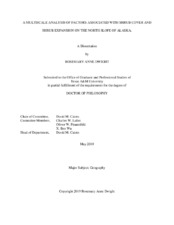| dc.description.abstract | Species distributions are expected to shift with changes in climate at a global scale. The northern latitudes are warming at a rate three times greater than the global mean, which has resulted in the Arctic tundra undergoing many environmental changes in addition to increasing temperatures. One of the most notable changes is that of shrub expansion. Shrub expansion is an important process to understand since it impacts local thermal regimes, and carbon sequestration or release. The aim of the research was to determine where key areas of shrub cover and shrub expansion are to aid in understanding how much of the North Slope of Alaska is likely to support increased shrub growth. This was achieved by addressing the following three questions: 1) How is shrub cover distributed at the regional scale and what regional environmental variables is it associated with? 2) How is shrub cover distributed, and where are the key areas of expansion at the landscape scale? 3) How do shrubs respond to a local disturbance?
I used a combination of historical and contemporary imagery to analyze the patterns of shrub cover and shrub expansion at regional, landscape, and local scales on the North Slope of Alaska. The images were classified using a maximum likelihood classification process in ENVI, and then analyzed in ArcGIS. The relationships between shrub cover and shrub expansion, and selected environmental variables were determined statistically using R. The findings of this research suggest that: 1) shrub cover on the North Slope exhibits a latitudinal gradient, with greatest coverages in the southern areas; 2) shrub cover is greatest in river floodplains, but the greatest rates of expansion are on floodplain slopes, and within the first ten meters of streams; and 3) shrub colonization has been facilitated by processes linked to the disturbance of the Trans-Alaska Pipeline System. The combination of these findings provide better understanding of where key areas of shrub expansion are on the North Slope of Alaska, which will aid in improving Arctic vegetation models. | en |


